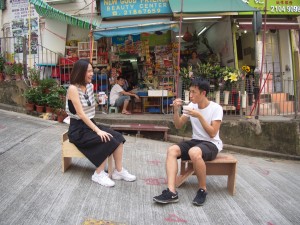斜路木凳 Ramper Stool
by KaCaMa Design Lab
正街是一條從南至北將山和海連起來的下坡路,也是香港斜度最高的道路(最斜有1:4)。它就像西營盤的中軸,拾級而上,貫串第一街、第二街、第三街及高街,兩側有東邊街和西邊街,形成「目」字形的街道規劃。因其地理位置,加上有正街街市在其中,本是街坊必到之處,但其長命斜特性,令人難以停留,區內也沒有足夠的固定休憩空間。然而一個社區不能沒有讓人歇息的地方,於是Kacama設計了一款適合斜路使用的靈活木凳,方便居民閒坐,多點落街活動,促進社區交流。
斜路木凳的設計特色是十分自助,製作方法簡單,街坊可以參照附圖,在西營盤區內找到所有相關物料,包括紅酒箱及木行的卡板碎料,只要鑽上兩排小洞,對應不同街道調校斜度,自製一張可水平而坐的木凳。在樓梯使用,它又會變成一張小几。
我們想像日後街坊會帶著自製小凳,去參與社區裡的各種活動,例如放映會和居民大會,也可三三兩兩的飲茶聊天,或者只是閒閒地坐著,享受那由高而下的山城美景。
Centre Street is a downhill road that runs from South to North bridging up the hill and the sea, and is the steepest road in Hong Kong (the steepest part has the gradient of 1:4). It is the middle axis of Sai Ying Pun crossing First Street, Second Street, Third Street and High Street upward. With Eastern Street and Western Street on two sides, the street network is laid out in the shape of a square. Centre Street is popular for its convenient location and the presence of the Centre Street Market. Yet, people do not usually stay or hang around due to the very steep slope. In view of the needs for a space to rest which is actually scarce in the district, Kacama designed a flexible wooden stool that can be used on steep slopes so that neighbours could take rest and interact with each other.
One main design feature of the wooden stool is that it is easy to make and self-manageable. Neighbours could reference to the picture provided and find all necessary materials, such as wooden wine boxes and pallet pieces, in Sai Ying Pun. All you have to do is to bore two rows of tiny holes and adjust the inclination according to the steepness of different slopes and make your own leveled wooden stool. When you use it on staircases, it even becomes a little table. We imagine the future in which neighbours would carry their own handmade stools to participate in different community activities, such as movie screenings or resident meetings, as well as to gather for tea and chit-chats, and enjoy the scenic view looking down the hill.
斜路木凳製作 The Making of Ramper Stool :
材料 Materials:
- 紅酒箱 15.7x33x46(cm) 1個 Red wine box x 1 each
- 6分夾板 31×40(cm) 2塊 18mm plywood x 2 pieces
- 不鎸鋼螺絲加絲母 4粒 Stainless steel screws and nuts x 4 each
- 木方 1條 Flitch x 1 piece
步驟 Procedure:
- 將木方鋸成適當的長度,并螺絲固定在紅酒箱中間 Cut the flitch into the appropriate length and fix it to the centre of the wine box with screws
- 在紅酒箱離邊位3.5cm處,由箱底開始,每隔2.5cm 的高度用1/4鑽嘴,鑽孔。四邊如是
Mark at 3.5 cm from the side of the wine box, use 1/4” drill bit to bore a hole every 2.5cm in a vertical row. Applied to the four sides
- 在夾板兩邊離邊位2.5cm處,每隔2.5cm 的高度用1/4鑽嘴,鑽孔。每邊12個
Mark at 2.5cm from the side of the wine box, use 1/4” drill bit to bore 12 holes with an interval of 2.5cm
- 用不鎸鋼螺絲加絲母把巳鑽孔的夾板固定在紅酒箱上
Fix the holed plywood plates to the holed wine box with the stainless steel screws and nuts
- 不鎸鋼螺絲需要打對角安裝
Fix the screws diagonally on each plywood plate
- 完成後可隨意調較兩邊夾板高度,以配合不同情況需求
Of the completed stool, the two sides’ length can be adjusted to deal with different gradients
關於 About
KaCaMa Design Lab
KaCaMa Design Lab是一個來自香港的產品設計團隊,擅長利用廢料加工製作。希望透過自家設計,為人們的生活帶來點綴,提升用對環保的觸覺。并且能建立大家與當地企業,手工藝和當地文化的接觸。品牌成立至今曾獲邀參與多個國際性展覽,其別具創意及環保的產品更被列入國際著名出版社viction:ary的設計作品大全。
KaCaMa Design Lab is a Hong Kong-based product designers who specializes in reusing post-consumer waste materials. They hope their product not only can delight people’s lives and instill eco-awareness in its users, but also can establish contact with local enterprises, handcraft men and local cultures. It was invited to participate in a number of international exhibitions. Its innovative and environmental-friendly products were also included in the design portfolio of the renowned international publisher viction:ary.
聯絡 Contact
Email: info@kacama.hk




